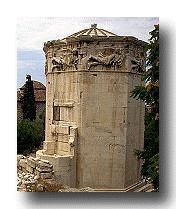WHO WAS FAVONIUS?
Favonius Deus Romanus ventus Occidentalis
In Roman mythology Favonius was the west wind personified—a 'son' of Aeolus if you like. The Romans adopted the Greek Pantheon giving the Gods their own Roman names. [Hover over the left image to see a line drawing.]
Favonius' Greek mythological counterpart had the name of Zephyros. Favonius' other Roman 'brothers' were Aquilo (North wind), Auster (South wind) and Eurus (East wind). Find these words in a Latin dictionary.There are eight wind deities, listed below, which are depicted on the frieze around the top of the 'Tower of the Winds' in Athens.
The 'Tower of the Winds' (Temple of the Winds) or more correctly, the Horologion of Andonikos Kyrrhestes stands in the Roman Agora in Athens. Some also call it the "Tomb of Socrates" but I doubt this is true. The octagonal structure stands over 12 metres high and with a diameter of ~8 metres (3,2m on each side). It was built by the Greek/Syrian astronomer Andonikos around 50 BC (or 2nd century) as a combination of *sun dial, weather vane, and klepsydra, or water clock. Made of local marble, it is decorated on each of its sides with a bas relief of an anthropomorphic wind deity: each sculpted figure in the frieze represents one of the eight winds facing the eight compass points. These winds are represented as winged, floating figures 'flying' through the air. Beginning at the North side and proceeding clockwise the figures represent:
- North - Boreas (Aquilo) in a heavy cloak, he is blowing trough a twisted shell.
- North East - Kaikias carries and empties a shield full of hailstones.
- East - Apeliotes is carrying fruit and grain.
- South East - Euros (Eurus) is depicted as an old man threatening a hurricane.
- South - Notos (Auster) is emptying an urn thus producing a shower of rain.
- South West - Lips pushes at the stern of a ship, promising a good sailing wind.
- West - Zephyros (Favonius) showers a lapful of flowers into the air.
- North West- Skiron is carrying a bronze pot full of hot ashes and charcoal.
*Bronze rods were used to cast shadows upon sundials on the tower's sides, this allowed a reading of the time of day whatever the season. Other marks on the walls surfaces helped to gauge the length of these bronze rods' shadows. Atop the structure, a Triton-shaped bronze weather vane once indicated the wind direction. The water clock was powered by water piped from a spring in the Acropolis.
For more on the Tower of the Winds see Sophia Athanasiou & Panagiotis Sarantopoulos': PowerPoint presentation
Renaissance Art, Mythology and Allegory
Well, that's me just there, Favonius, (Zephyros) top left with the missus, Flora (or Chloris as the Greeks called her.) My old mate Sandro Botticelli painted this picture, the Birth of Venus, way back in 1485. (click thumbnail for larger image)
Flora and I are flying in with our legs entwined: I'm puffing vigorously as usual, while my dearest Flora gently sighs the warm breath that wafts Venus, or Aphrodite as the Greeks called her, ashore on a scallop shell (a pagan sign of fertility and female genitalia?). The point where her foot touches is the supposed site of the first rose bush.
All around us Flora makes roses fall—each one with a golden centre (real gold leaf in the enormous painting in the Uffizi Gallery in Florence). This all took place on the island of Cyprus where Aphrodite washed up on the beach at Paphos. In the background of the painting is an orange grove with tiny white flowers which can hardly be made out; Thallo on the right stands on anemones (wind flowers).
Thallo was one of the Horae, (hours or the three seasons—there were only three in those days) It's Spring, she wears a necklace of myrtle, a golden diadem and a sash of pink roses round her white dress decorated with blue (pigment of lapis lazuli) cornflowers; she brings a 'purple' (representing birth and death) embroidered cloak (looks more red to me) to cover Aphrodite or Venus' chaste modesty as she is 'born' from her shell.
What a cracker, eh? Venus or Aphrodite was, in fact, modelled on Italian renaissance beauty Simonetta Vespucci, a Florentine and the 1475 'Queen of Beauty'. (Mind you Sandro's done something with her left shoulder—it looks a bit wonky don't you think? He got my toes wrong too.) You don't want to know how Aphrodite or Venus was conceived (i.e. what was thrown in the sea to fertilize it, according to Hesiod); suffice it to say that Uranus was missing a vital part of his anatomy thanks to his terrible Titan son Chronus.
Favonius, a.k.a. Graham Woods
